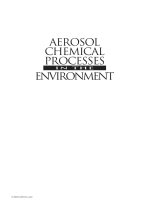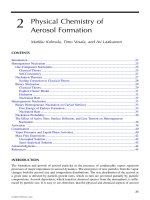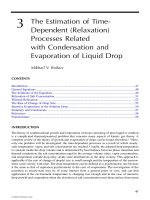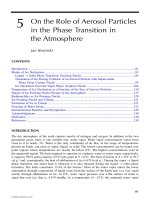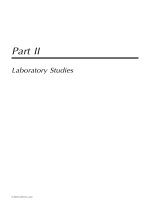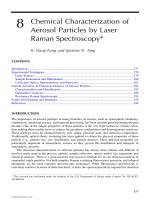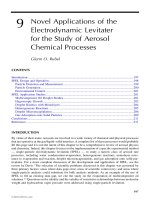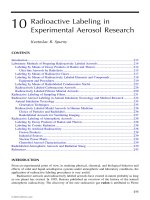AEROSOL CHEMICAL PROCESSES IN THE ENVIRONMENT - CHAPTER 10 docx
Bạn đang xem bản rút gọn của tài liệu. Xem và tải ngay bản đầy đủ của tài liệu tại đây (5.5 MB, 34 trang )
213
10
Radioactive Labeling in
Experimental Aerosol Research
Kvetoslav R. Spurny
CONTENTS
Introduction 213
Laboratory Methods of Preparing Radioactively Labeled Aerosols 214
Labeling by Means of Decay Products of Radon and Thoron 214
Ultra-fine Aerosols by Radiolysis 215
Labeling by Means of Radioactive Gases 217
Labeling by Means of Radioactively Labeled Elements and Compounds 218
Equipment and Procedures 219
Labeling by Means of Radiolabeled Condensation Nuclei 222
Radioactively Labeled Carbonaceous Aerosols 226
Radioactively Labeled Fibrous Mineral Aerosols 228
Radioactive Labeling of Sampling Filters 231
Radioactive Aerosol Labeling in Animal Inhalation Toxicology and Medical Research 234
Animal Inhalation Toxicology 235
Generation Techniques 235
Radioactively Labeled Model Aerosols in Human Medicine 236
Choice of Particles and Radiolabel 236
Radiolabeled Aerosols for Ventilating Imaging 237
Radioactive Labeling of Atmospheric Aerosols 238
Labeling by Decay Products of Radon and Thoron 238
Labeling by Cosmic Radiation 238
Labeling by Artificial Radioactivity 238
Fission Products 238
Industrial Sources 239
Nuclear Power Plants 239
Chernobyl Aerosol Characterization 239
Radiolabeled Atmospheric Aerosols and Radiation Smog 239
References 243
INTRODUCTION
From an experimental point of view, in studying physical, chemical, and biological behavior and
effects of solid and liquid aerodisperse systems under atmospheric and laboratory conditions, the
application of radioactive labeling procedures is very useful.
Radioactive aerosols and radioactively labeled aerosols have existed in nature probably as long
as our planet has existed. In 1995, Renoux published an overview of the history of the natural
atmospheric radioactivity. The discovery of the rare radioactive gas
radon
is attributed to Pierre
L829/frame/ch10 Page 213 Wednesday, February 2, 2000 11:39 AM
© 2000 by CRC Press LLC
214
Aerosol Chemical Processes in the Environment
and Marie Curie in 1898 and Dorn in 1900. Thoron (
220
Rn) was discovered by Rutherford and
Owens in 1899–1900, and actinon (
219
Rn) by Debierne and Geisel about the same time.
The first scientist to find radioactive aerosols was Marie Curie in 1905.
2
She studied the influence
of gravitational field on the decay products of radon. Radon’s radiotoxicity was first studied in
France in 1904 by Bouchard and Balthazard, and in 1924 it was hypothesized that the great mortality
observed in uranium mines of Schmeeberg in Germany and Joachimsthal in Czechoslovakia was
due to radon. In 1939, Read and Mottram found that radioactive aerosols are biologically more
effective than radon itself.
2,3
Elster and Geitel were the first to see (in 1901) that radioactivity is
present in the atmosphere.
1
Since World War II, radioactive aerosols have become well known, and the object of increasing
studies and use. Their physical properties and effects started to be intensively studied in the 1950s.
Wilkening estimated the size distribution of the natural radioactive aerosols in the atmosphere in
1952 and, in 1959, Jacobi found that more than 50% of the natural atmospheric radioactivity is
deposited on aerosol particles smaller than 0.2
µ
m. The first theory of small particle labeling by
radioactive ions was developed by Bricard in 1949.
The exploitation of radioactive labeling in aerosol research also dates back to the 1950s.
Nevertheless, a very fast development started about ten years later.
3
Since that time, basic theoretical
investigations have led to a complex description of the nuclear methods applied in physical and
chemical research.
4
What is the difference between a radioactive aerosol and a radioactively labeled aerosol? There
may be no precisely definable difference. From a historical point of view, all radioactively labeled
aerosols in the atmosphere and space are called radioactive aerosols. But from a radiochemical
point of view, for aerosols used in the laboratory conditions, it is best to use the expression
“radioactively labeled aerosols.” This means that only some aerosol particles are radioactive, and
that only a portion of each particle is in fact radioactive. In contrast, the expression “radioactive
aerosol” means that all particles are radioactive, and that each particle consists predominantly of
radioactive species.
LABORATORY METHODS OF PREPARING RADIOACTIVELY
LABELED AEROSOLS
Different methods can be used in the preparation of radioactively labeled aerosols under laboratory
conditions. The most important labeling methods for practical and laboratory purposes are listed
in Table 10.1. Neutron activation of the aerosol itself (method 1) is not very suitable or economical,
and therefore will not be discussed here. The most suitable methods are those in which the aerosol
is first prepared with the desired properties, and the particles are then labeled by condensing a
radioactive substance on their surfaces (methods 2 and 3). Another convenient method for preparing
radioactively labeled aerosols involves condensation or dispersion of radioactive substances (method
4). The processes of preparing radioactive nuclei (method 5) and preparing condensation aerosols
can be combined.
L
ABELING
BY
M
EANS
OF
D
ECAY
P
RODUCTS
OF
R
ADON
AND
T
HORON
This method is used very often and is similar to the natural radioactive labeling of fine aerosol
particles in the atmosphere. Through a diffusion process, the natural aerosols are labeled by means
of radon and thoron decay products.
3
The relative distribution of the activity on particles of different
sizes was first described by Lassen in 1965.
5
This distribution function was constructed assuming
the validity of Junges’s distribution of natural aerosols,
6
including the condition of coagulation (see
Table 10.1). Wire screen diffusion batteries have been found to be the most suitable method for
measuring the activity size distribution of radon and thoron progeny.
7-9
L829/frame/ch10 Page 214 Wednesday, February 2, 2000 11:39 AM
© 2000 by CRC Press LLC
Radioactive Labeling in Experimental Aerosol Research
215
The short-lived decay products of
222
Rn and
220
Rn are formed initially in an atomic, positively
charged state that rapidly combines with submicron (mainly with nano-sized) aerosols. The resulting
ultra-fine aerosols consist of a complex mixture of charged and neutral particles. Under normal
conditions, the average electrical charge of the
222
Rn and
222
Rn progeny atmosphere is substantially
less than one elementary unit. The electrical charge distribution is mostly symmetrical.
10-13
The decay-product method of labeling is relatively easy to use in the laboratory. An artificial
inactive aerosol is passed through a cylinder filled with radon or thoron. When aerosol particles
remain in this atmosphere for a sufficient length of time, they become alpha-radioactive. It should
be noted, however, that if concentrations of thoron greater than about 1
µ
Ci (27 kBq)/liter are used,
aerosols may be produced by radiolytic reactions with impurities in the air. these may also become
labeled with ThB and confuse the picture.
3
Ultra-fine Aerosols by Radiolysis
It has been reported for many years that condensation nuclei can be produced by ionizing radiation.
For example, radiolysis following the decay of
222
Rn results in the production of ultra-fine aerosols.
Recent studies were able to improve the measurement of activity size distribution of these ultra-
fine particles produced by radon and its daughters. It has been found that the activity that was
conventionally referred to as the “unattached” fraction is actually an ultra-fine particle aerosol from
water molecule radiolysis with a size range of 0.5 nm to 3 nm.
14
Oxidizable species such as SO
2
react promptly with hydroxyl radicals and form a condensed phase. These molecules coagulate and
become ultra-fine particles. The size distribution of these ultra-fine particles can be shifted upward
with the increase of SO
2
concentrations.
Further investigation
13
showed that
218
Po formed — during radon decay in well-controlled
composition atmospheres (e.g., N
2
) — clusters in the size range between 0.7 nm and 2.0 nm. Figure
10.1 shows the diagram of such a
218
Po cluster generation system. The size of the produced clusters
could be efficiently measured by means of a SMEC (
spectrometre de mobilite electrique circulaire
)
device.
The clusters formed in the radiolysis of radon include progeny particles and nonradioactive
particles. In more recent investigations, the activity size distributions of
212
Pb- and
212
Bi-borne
nanometer particles were produced and measured. When thoron gas enters the spherical chamber
(Figure 10.2), it soon decays to
212
Pb and can be oxidized. Since most
212
Pb ions have positive
charge, they attract polar molecules and form clusters. The cluster sizes measured by means of a
diffusion battery (DB) were less than 2 nm.
9
TABLE 10.1
Some Methods for Preparing Radioactively Labeled Aerosols
1. Preparation by means of
neutron activation
of aerosols in a nuclear pile or other
neutron source (not very suitable).
2. Labeling by means of
decay products
of radon and thoron. Relative distribution of
activity on particles of different sizes (L. Lassen):
A
(
r
) d
r
=
Φ
(
r
)
N
(
r
) d
r
3. Labeling by means of
radioactive gases
(Rn, Tn, Xe, etc.) in high-frequency discharge
at low pressure.
4. Preparation by means of
radioactively labeled elements and compounds
(condensation
aerosols, disperse aerosols, and plasma aerosols).
5. Preparation by means of
radioactively labeled condensation nuclei
.
L829/frame/ch10 Page 215 Wednesday, February 2, 2000 11:39 AM
© 2000 by CRC Press LLC
216
Aerosol Chemical Processes in the Environment
FIGURE 10.1
Schematic diagram showing the system for the generation of
218
Po cluster aerosols. (From
Mesbah, B., Fitzgerald, B., Hopke, P.K., and Pouprix, M.,
Aerosol Sci. Technol.,
27, 381-393, 1997. With
permission.)
FIGURE 10.2
Experimental setup for the generation and measurement of nanometer-sized
212
Pb- and
212
Bi-
borne particles. (From Chen, T.R., Tung, C.J., and Cheng, Y.S.,
Aerosol Sci. Technol.,
28, 173-181, 1998. With
permission.)
L829/frame/ch10 Page 216 Wednesday, February 2, 2000 11:39 AM
© 2000 by CRC Press LLC
Radioactive Labeling in Experimental Aerosol Research
217
L
ABELING
BY
M
EANS
OF
R
ADIOACTIVE
G
ASES
This method consists of exposing an aerosol or an aerosol sample to a high-frequency discharge at
low pressure in a mixture of radon, krypton, or xenon, etc., and air. The atoms of a radioactive gas,
ionized and accelerated in the electric discharge, penetrate and are retained on the surface of the
aerosol particles. The method of labeling has two attractive features. First, the position of individual
particles can be determined by autoradiography. When radon is used for labeling and radiography is
carried out with nuclear emulsion, individual particles show up in the radiogram as stars consisting
of the tracks of alpha-rays (Figure 10.3). The frequency of the tracks in each star is an indication of
the particle’s size. Second, the action of a suitable gaseous medium (a chemical surface reaction) on
the aerosol particles can release the radioactive gas from the aerosol sample. This feature provides
the possibility of chemically identifying individual particles in the aerosol sample.
An aerosol can be activated directly in a suspended state, independent of its chemical compo-
sition, in a stream of gas. By repeated measurements of aerosol activity, the aerosol concentration
can be measured continuously. Labeling with decay products of radon is most suitable for these
purposes, because the radon is not used in gaseous form and is attached to the surface of the solid
substances. Radon can be firmly fixed, for example, on the inner wall of a glass tube with the aid
of an electric discharge at low pressure.
15,16
The radon is retained near the surface and a large
proportion of the RaA atoms originating from the decay are ejected by recoil into the gas inside
the tube. Because of their low energy, these atoms traverse a small distance, roughly 0.1 mm; and
if the air is free of aerosols, they quickly diffuse back to the surface of the tube, where they are
retained. If the air contains aerosol particles, however, some of the RaA atoms are retained by the
aerosol; and the retention of RaA atoms increases with increasing concentration of the aerosol.
An instrument for continuous measurements of inactive aerosol concentration, based on this
principle, was built and described by Jech in 1963.
16
The function of the instrument is shown
schematically in Figure 10.4. The aerosol sample in air flows at a speed of roughly 0.25 1/min
through the activating tube (A), which contains 5 to 10 mCi (185 to 370 MBq) radon. The activated
aerosol emerges from the tube, is filtered by a Millipore filter (F), and its activity is measured
differentially. The activity of the filter was continuously measured by a Geiger-Müller counter (in
its proportional region); and the counts were integrated and registered by the ratemeter (Rm) and
FIGURE 10.3
The tracks of alpha-rays from single aerosol particles.
L829/frame/ch10 Page 217 Wednesday, February 2, 2000 11:39 AM
© 2000 by CRC Press LLC
218
Aerosol Chemical Processes in the Environment
recorder (Rg). The relative amount of RaA atoms retained by individual particles was dependent
on the size of the particles as well as on the numerical concentration of the aerosol. Therefore, the
instrument had to be calibrated for an aerosol of given dispersity.
17
L
ABELING
BY
M
EANS
OF
R
ADIOACTIVELY
L
ABELED
E
LEMENTS
AND
C
OMPOUNDS
In this case, there are two principle possibilities: (1) preparation of dispersed aerosols by spraying
or nebulizing solutions or powders; and (2) preparation of condensation aerosols by spontaneous
vapor condensation, or vapor condensation in the presence of radioactive condensation nuclei.
The first method has some disadvantages: the possibility of contamination is great; the con-
sumption of radioactive material is large; and the aerosol particles show little specific radioactivity.
Nevertheless, it was used in some cases to great effect in the 1960s and thereafter.
18
However, the second possibility — the use of condensation methods — provides highly
dispersed aerosols, approximately monodisperse, and the particles show a high specific radioactivity.
Through the nucleation process, the particle size and the aerosol concentration can be changed by
changing the supersaturation of the vapor. From nucleation theory, it is known that the particle
concentration for a given time is an exponential function of the supersaturation of a vapor. This
supersaturation is controlled in practice by changing the evaporation temperature of the substance
and the flow rate of dilution gas. When all conditions are constant, the concentration can be
calibrated and the particle size determined as a function of evaporation temperature and gas flow,
the particle size being measured with an electron microscope, diffusion battery, etc.
19
The chemical elements and compounds for preparing condensation aerosols have to be stable;
they should not decompose on heating. Evaporation is often accompanied by oxidation, so that the
aerosol being prepared becomes oxidized. Tables 10.2 and 10.3 describe the elements and inorganic
and organic compounds that are suitable for preparing condensation aerosols and which are easy
to label with different radioisotopes. Table 10.4 shows more detail concerning some radioactively
labeled inorganic condensation aerosols that were described and used in laboratory experiments in
the 1960s.
19-27
FIGURE 10.4
Schematic diagram of apparatus for continuous recording of aerosol concentration, and an
example (inset) of a recording that shows aerosol concentration in unfiltered and filtered air from the laboratory.
A = activating tube; F = Millipore
®
filter; GM = Geiger–Müller tube; Rm = ratemeter; Rg = recorder; S =
lead shield; D = revolving metal disk; P = pump; CPM = counts per minute, t = time.
L829/frame/ch10 Page 218 Wednesday, February 2, 2000 11:39 AM
© 2000 by CRC Press LLC
Radioactive Labeling in Experimental Aerosol Research
219
Equipment and Procedures
Different kinds of equipment can be used for spontaneous condensation under constant conditions.
Three of them have proven to be very suitable for the generation of highly dispersed radiolabeled
condensation aerosols. Such model aerosols make it possible to measure more rapidly and sensi-
tively numerous processes in the mechanics of aerosols (e.g., coagulation, phase transformation,
filtration, deposition, etc.).
TABLE 10.2
Inorganic Material Suitable for Preparing
Radioactively Labeled Condensation
Aerosols
Element or
Compound
Melting Point
(°C)
Temperature (°C)
at Vapor Pressure
10
–5
mmHg
Hg –38.9 126.2
H
2
SO
4
10.5 145.8
Ga 30 1349
H
4
P
2
O
7
61 —
Se 217 356
Re
2
O
7
296 215.5
Tl 303.5 825
SeO
2
340 157
Te 452 520
AgCl 455 912
BeI
2
488 283
PbCl
2
501 547
LiF 547 1047
AgI 552 820
CsI 621 738
CsBr 636 748
CsCl 646 744
NaI 651 767
V
2
O
5
690 —
NaCl 800 865
Ag 961 767
Au 1063 1083
Mn 1244 717
Be 1284 942
Si 1410 1024
Ni 1455 1157
Co 1478 1249
Fe 1535 1094
V 1710 —
Pt 1774 1606
Cr 1900 907
SrO 2430 2068
Mo 2622 1923
Os 2697 2101
Ta 2996 2407
W 3382 2554
L829/frame/ch10 Page 219 Wednesday, February 2, 2000 11:39 AM
© 2000 by CRC Press LLC
220
Aerosol Chemical Processes in the Environment
Furnace Generators
The apparatus for the generation of condensation aerosols by sublimation of the solid phase or by
evaporation of the liquid phase or inorganic substances consists of an electric furnace in which the
substance under study is heated to an adjustable and controlled temperature. The dry gas passing
through the furnace at an adjustable flow rate is enriched with the vapor or aerosol particles of the
same substance used. After passing through the furnace, the gas with aerosol particles is led into
a condenser and then into a homogenizer. Several types of furnace, each specially designed for an
individual aerosol or aerosol group, proved suitable.
19-27
A longitudinal furnace (Figure 10.5) was employed to prepare sodium chloride aerosols.
19
A
ceramic tube was heated by two electric coils. In the first part of this tube, radiolabeled NaCl [
24
Na,
10 to 500 mCi (370 MBq to 18.5 GBq)] was heated to the desired temperature in a porcelain boat.
The second part of the tube was heated to a temperature about 10% higher than that in the first
part. A vertical furnace (Figure 10.6) was employed to prepare silver iodide aerosols. The furnace
consisted of two halves that were heated by electric, ceramic heating elements with a power output
of 800 W. The gas entered the space over the substance (AgI) in the middle of a sealed silica tube.
The vapor and the aerosols of silver iodide were drawn off from the upper part of the furnace. The
yellow powder of AgI was added through a wider tube into a platinum crucible placed on the
bottom of the tube. The AgI can be radiolabeled by
131
I or by
110
Ag.
For substances with a low melting point or high vapor pressure (e.g., Se, SeO
2
, H
2
SO
4
, H
4
P
2
O
7
),
an apparatus with a double glass orifice was found suitable (Figure 10.7). Here, a vapor was
condensed in a gas stream. After going through the double orifice (2), the vapor and cold clean
gas were combined in the mixing reservoir (5). The produced aerosols were radiolabeled by
35
S,
75
Se, and
32
P.
19
TABLE 10.3
Organic Compounds Suitable for Preparing Condensation
Aerosols (Radioactive Labeling by Means of Radioactive
Condensation Nuclei)
Compound Formula
Melting Point
(°C)
Temperature (°C)
at Vapor Pressure
1 mmHg
Dichloro-1-naphthylsilane C
10
H
8
C
l2
Si — 106.2
Trethylene glycol C
6
H1
4
O
4
— 114.0
Tetraethylene glycol C
8
H
18
O
5
— 153.9
Nitroglycerine C
3
H
5
N
3
O
9
11.0 127.0
Capric acid C
10
H
20
O
2
31.5 125.0
Palmitic acid C
16
H
32
O
2
64.0 153.6
Diacetamide C
4
H
7
NO
2
78.5 70.0
Glutaric acid C
5
H
8
O
4
97.5 155.5
Acridine C
13
H
9
N 110.5 129.4
Resorcinol C
6
H
6
O
2
110.7 108.4
Sebacic acid C
10
H
18
O
4
133.0 —
Adipic acid C
6
H
10
O
4
152.0 159.5
Hydroquinone C
6
H
6
O
2
170.3 132.4
Benzanthrone C
17
H
10
O 174.0 225.0
Hexachlorobenzene C
6
C
l6
230.0 114.4
Dioctyl sebacate C
26
H
50
O
4
——
Dioctyl-phthalate C
18
H
30
O
4
——
Dibutyl-phthalate C
16
H
22
O
4
——
L829/frame/ch10 Page 220 Wednesday, February 2, 2000 11:39 AM
© 2000 by CRC Press LLC
Radioactive Labeling in Experimental Aerosol Research 221
Wire Generators
Aerosol generators in which metal wires can be evaporated have also proved very suitable. This
type of condensation aerosol generator produces a constant concentration of aerosol particles and
constant particle sizes; these are reproducible. Furnace generators require a few hours before they
work stably. On the other hand, wire generators, 10 minutes after they are turned on, produce
constant particle sizes. The preparation of radioactively labeled aerosols from platinum wire and
nickel-chromium wire were reported in the middle of the 1960s.
28,29
The principle of such a generator is shown in Figure 10.8. Clean, dry, and preheated air (G)
flows across a platinum wire, which is heated electrically. The produced aerosols can be labeled
by
197
Pt and
199
Au. Similarly, other types of metal wires have been found suitable, such as Re (
186
Re,
188
Re), Au (
198
Au), etc.
22
Another apparatus that can be used for preparing radiolabeled aerosols by wire evaporation is
a “plasma” aerosol generator.
30
The principle of this method is shown in Figure 10.9. The tungsten
or platinum wire (W) is exploded using energy stored in a bank of condensers (about 30 J). Such
wire explosions are possible in atmospheres of various gases.
31
Sintering Metal Generators
Highly dispersed silver aerosols have found useful applications in various physical, chemical, and
biological investigations. Generation procedures for this metallic aerosol have been reported in
several publications since the middle 1970s.
32
TABLE 10.4
Radioactively Labeled Inorganic Condensation Aerosols
Compound or
Element
a
Temperature
Range (°C)
Range of Particle
Radii (µµ
µµ
m)
Radioactive Isotopes
(half-life)
Pt-oxides, mo, s 600–1300 5 × 10
–3
–3 × 10
–2 197
Pt (18 h)
199
Au (3 d)
Ag, s 600–1300 2 × 10
–2
–2 × 10
–1 110
Ag (249 d)
Au, s 700–1200 10
–2
–10
–1 198
Au (2.7 d)
WO
3
, N
2
, mo, s 900–1200 2 × 10
–2
–8 × 10
–2 185
W (73 d)
NaCl, mo, s 400–1100 3 × 10
–3
–10
–124
Na (15 h)
22
Na (2.6 y)
V
2
O
5
, s 400–950 5 × 10
–2
–1.5 × 10
–150
V (6 × 1014 y)
Se, N
2
, mo, s 150–300 3 × 10
–2
–3 × 10
–175
Se (27 d)
Te, N
2
, mo, s 200–300 10
–2
–5 × 10
–2 127
Te (105 d)
Re(Re
2
O
7
), s 100–350 4 × 10
–3
–3 × 10
–2
High spec. act.
186
Re (90 h)
188Re (17 h)
AgI, N
2
, mo, s 200–600 5 × 10
–2
–3 × 10
–1 131
J (8 d)
110
Ag (249 d)
H
4
P
2
O
7
, s 150–300 10
–2
–10
–132
P (14 d)
H
2
SO
4
, l 50–200 10
–1
–10°
35
S (87 d)
Hg, N
2
, l 50–200 5 × 1
0–1
–10
–1 203
Hg (48 d)
AgCl, s, N
2
350–1000 10
–2
–7 × 10
–1 110
Ag (249 d)
Fe(Fe
2
O
3
), s, air 450–800 2 × 10
–3
–1.5 × 10
–255
Fe (2.5 y)
GaCl
3
, s, N
2
, air 60–200 0.4–2.5
67
Ga (78 h)
S, s, He 50–200 10–1
–5
× 10
–135
S (87.6 d)
Tl, s, N
2
300–700 2 × 10
–3
–5 × 10
–3 204
Tl (3.9 y)
a
mo = monodisperse aerosol; s = solid; l = liquid.
L829/frame/ch10 Page 221 Wednesday, February 2, 2000 11:39 AM
© 2000 by CRC Press LLC
222 Aerosol Chemical Processes in the Environment
Sutugin et al.
33-36
have developed a fundamental theoretical basis for the nucleation of metal
and metal oxide molecules, and their results were later exploited for practical aerosol preparation.
The Ag-aerosol can be easily radiolabeled. At the end of the 1970s, Spurny developed and
described a generator for highly dispersed (Ag +
110
Ag) aerosols.
27
In this generator, disks of sintered
silver particles (produced as “silver membrane filters” by Flotronics, U.S.) were used as the initial
material (Figure 10.10). The disks were labeled with
110
Ag by neutron activation.
A schematic and a photograph of the apparatus for preparation of condensation aerosols of
radiolabeled silver are shown in Figure 10.11. The silver filter disk (Ag) was heated by electric
current. Nitrogen, helium, or argon was used as the inert gas. Approximately monodisperse radio-
labeled aerosols of silver were prepared at furnace temperatures between 400 and 1000°C. (Ag
melting point is 960.8°C.) In the temperature range below the melting point (400 to 950°C), very
fine aerosols could be obtained at concentrations between 10 ng l
–1
and 5 µg l
–1
. Mean particle
diameters ranged between about 2 nm and 6 nm. At temperatures above the melting point (sintered
silver was maintained in a porcelain boat), the particle sizes increased rapidly up to over 0.1 µm
(Figure 10.12). This aerosol reacts easily with gases and vapors, such as O
2
, H
2
S, Cl
2
, Br
2
, I
2
, etc.
LABELING BY MEANS OF RADIOLABELED CONDENSATION NUCLEI
The condensation methods described can be used to prepare aerosols of relatively small particle
size; for example, those smaller than 0.5 µm in diameter. However, these methods are not convenient
for labeling organic aerosols because oxygen has no usable radioisotopes, and carbon and hydrogen
yield soft radiation. In such cases, preparation by means of radiolabeled condensation nuclei should
be considered.
A combination of two kinds of aerosol generators is useful for the preparation of liquid organic
aerosols labeled by radioactive nuclei. It is composed of a furnace generator for preparing radio-
active condensation nuclei, and a modified Sinclair-LaMer generator (Figure 10.13). An organic
FIGURE 10.5 A longitudinal furnace for preparing inorganic condensation aerosols. 1 = boat containing
porous ceramic and an inorganic substance; 2 = metal shield; 3 = ceramic and asbestos shield; 4 = reheater;
5 = adjusting screws; 6 = quartz tube; N
2
= nitrogen; T = thermometer; Va = Variac.
L829/frame/ch10 Page 222 Wednesday, February 2, 2000 11:39 AM
© 2000 by CRC Press LLC
Radioactive Labeling in Experimental Aerosol Research 223
compound (e.g., dioctyl-phthalate, dioctyl-sebacate, etc.) is absorbed on the surface of silica gel
(S). The organic vapor diffuses through the inner orifice (I) after heating. The condensation nuclei
pass through the diluting space (D2) and reach the outer orifice (O) radioactively labeled. Under
suitable conditions, organic vapor condensed on these nuclei. The degree of supersaturation in the
mixer D1 depends on the nature of the liquid, the velocity of both gas streams, the temperature of
the vaporizer, and the concentration of nuclei.
37
Good results were obtained with radiolabeled nuclei
of NaCl, Se, and H
4
P
2
O
7
.
20
Another useful generator for preparing radiolabeled organic aerosols was the apparatus
described by Prodi in 1970.
38
A collision generator disperses very diluted solutions of inorganic
substances (e.g., NaCl) (see Figure 10.14). After drying (C) fine condensation nuclei are introduced
into a thermostated bubbler (D) containing melted carnauba was. The outcoming particles act as
condensation nuclei and, as a result, a solid monodisperse wax aerosol is formed. This procedure
also works very well using radiolabeled nuclei. Good results were obtained by nuclei of
24
NaCl
and (NH
4
)
6
99
Mo
7
O
24
⋅ 4H
2
O (see Figure 10.15).
25
Solid nuclei of
99
MoO
3
were also successful.
26
The ammonium paramolybdate decomposes by
heating, and fine molybdenum trioxide is produced (Figure 10.16).
FIGURE 10.6 A vertical furnace for preparing inorganic condensation aerosols. 1 = platinum or gold dish
containing an inorganic substance; 2 = quartz tube; 3 = shields; 4 = metal cover; 5 = heating bodies; 6 = metal
network; T = thermometer; Va = Variac; A = aerosol; N
2
= nitrogen.
L829/frame/ch10 Page 223 Wednesday, February 2, 2000 11:39 AM
© 2000 by CRC Press LLC
224 Aerosol Chemical Processes in the Environment
FIGURE 10.7 Evaporation equipment with double orifice. 1 = dish containing an inorganic substance; 2
= double orifice; 3 = path of cold gas stream (G1); 4 = furnace; 5 = mixing reservoir; 6 = glass evaporator;
G2 = gas supply; T = thermometer; W = water for cooling; A = aerosol.
FIGURE 10.8 Platinum wire aerosol generator. 1 = platinum wire in a ceramic insulator; 2 = cooling
section; 3 = glass sphere for diluting; G = gas; A = aerosol.
L829/frame/ch10 Page 224 Wednesday, February 2, 2000 11:39 AM
© 2000 by CRC Press LLC
Radioactive Labeling in Experimental Aerosol Research 225
FIGURE 10.9 Schematic of a plasma aerosol generator. W = wire (e.g., a tungsten wire about 0.05 mm
in diam. and 2 mm long); N
2
= nitrogen; A = aerosol.
FIGURE 10.10 Scanning electron micrographs of the surface of a silver membrane filter (pore diameter
= 0.2 µm; different magnifications).
L829/frame/ch10 Page 225 Wednesday, February 2, 2000 11:39 AM
© 2000 by CRC Press LLC
226 Aerosol Chemical Processes in the Environment
RADIOACTIVELY LABELED CARBONACEOUS AEROSOLS
Carbonaceous (black carbon or soot) aerosols in polluted atmospheres are totally respirable, with
particle sizes less than 1 µm. They carry many, mostly organic, toxic substances (e.g., PAH, nitro-
PAH, etc.).
Radiolabeling is a very useful methodology for physico-chemical studies as well as animal
toxicological investigations of the production, behavior, and health effects of this group of aerosols.
Combustion processes are the most important source of production of carbonaceous aerosols in the
atmospheric environment.
FIGURE 10.11 Equipment for the preparation of silver aerosols. A = aerosol; Ag = silver filter; N =
nitrogen; HB = reheater; RO = tubular furnace; QR = quartz tube; TR = transformer.
L829/frame/ch10 Page 226 Wednesday, February 2, 2000 11:39 AM
© 2000 by CRC Press LLC
Radioactive Labeling in Experimental Aerosol Research 227
Therefore, it is also reasonable to use the combustion of well defined fuels for generating model
carbonaceous aerosols under laboratory conditions and to apply them in physical, chemical, and
animal toxicological studies. For radioactive labeling,
14
C is the most suitable radioisotope.
Very fine dispersed carbonaceous aerosols can be produced in the laboratory by an incomplete
combustion of acetylene or acetylene + benzene.
39,40
A mixture of acetylene, benzene, and oxygen,
introduced into a small special burner, is additionally and continuously labeled by a radioactive
gas or vapor (e.g., by
14
C-acetylene,
14
C-benzene, etc.). The system for very sensitive dosage of
the radiolabeled benzene vapor is schematically shown in Figure 10.17. The radiolabeled benzene
is available in glass vials (Ra-S). After opening, the vial is heated (heater D, regulation transformer
RT, and thermometer T) so that the rate of diffusion of the radiolabeled benzene vapor through
the glass fritt (F) into a chamber (M) can be well controlled. The original gas mixture (B) is
labeled by the
14
C-benzene (Ra-B) by this procedure, and is then introduced into the burner. The
fine carbonaceous aerosol thus produced is labeled by
14
C (Figure 10.18) and has specific activities
in the range 1 to 10 µCi (37 to 370 kBq)/mg. Such a model carbonaceous aerosol can be loaded
with different PAH (non-active or radioactive) and used in physico-chemical as well as toxico-
logical studies.
39
By studying the behavior of a benzo(a)pyrene (BaP) aerosol itself and in
combination with soot particles, different resublimation characteristic curves can be observed
(Figure 10.19).
Radiolabeled BaP-aerosol and a mixture of “soot” + BaP were sampled on silver membrane
or glass fiber filters. Then, the filter sample was gradually heated and the released radioactivity
was measured. The BaP alone could be completely resublimated very quickly. The BaP “coated”
on soot particles sublimated much more slowly, at higher temperatures, and incompletely. After
being heated at temperatures over 200°C, about 10% of the BaP was still bound on the soot
sample.
Similar useful labeling procedures can be applied directly in a diesel engine. Radiolabeled
diesel exhaust is then produced and can be used for physical, chemical, and mainly for inhalation
toxicological studies on animals.
41
A single-cylinder diesel engine was used to burn diesel fuel
containing trace amounts of
14
C-labeled hexadecane, dotriacontane, benzene, phenanthrene, or
benzo(a)pyrene. Greater than 98% of the
14
C in all additives was converted to volatile materials
upon combustion. It has been found that aromatic additives labeled carbon particles more efficiently
than aliphatic additives.
FIGURE 10.12 Scanning electron micrograph and size distribution curves of silver aerosol particles (par-
ticle diameter D and particle number frequency F) prepared at furnace temperature of 980°C.
L829/frame/ch10 Page 227 Wednesday, February 2, 2000 11:39 AM
© 2000 by CRC Press LLC
228 Aerosol Chemical Processes in the Environment
RADIOACTIVELY LABELED FIBROUS MINERAL AEROSOLS
Fibrous mineral aerosols belong in the group of aerosols consisting of nonspherical particles. The
particle shape, size, and chemical composition are parameters characterizing the physical, chemical,
as well as toxic effects of any fibrous aerosol.
42-51
The procedure of radioactive labeling is therefore of basic importance in physico-chemical and
toxicological studies in this field. The fibrous mineral aerosols are produced by dispersing natural
(mainly asbestos) and man-made (glass, ceramic, etc.) mineral fibers. These are mostly silicate
fibers containing several elements, which are often characteristic for different types of fibers, and
can be radiolabeled, for example, by irradiation with thermal neutrons in a reactor (by fluxes of
about 2.10
14
/cm
2
s).
Particle size — fiber diameter and fiber length — is involved in the dynamic behavior and in
the toxic health effects. Before labeling, the fibrous powders to be used should be well classified
with respect to fiber diameter and fiber length.
46
Such quasi-monodispersed powders (Figure 10.20)
can be irradiated for a period of 7 days.
42-45
FIGURE 10.13 Schematic of a condensation aerosol generator: aerosol particle size multiplier (APSM).
B = boat containing nucleus material; N2 = nitrogen; S = silica gel; DO = double glass orifice; I = inner
orifice; O = outer orifice; D1, D2 = glass spheres for diluting; H = heaters; T = thermometer; C = cooler; W
= water supply for cooler.
L829/frame/ch10 Page 228 Wednesday, February 2, 2000 11:39 AM
© 2000 by CRC Press LLC
Radioactive Labeling in Experimental Aerosol Research 229
FIGURE 10.14 Schematic diagram of the “Prodi”-generator.
FIGURE 10.15 Activity size distribution spectra with ammonium paramolybdate nuclei obtained at three
different temperatures.
L829/frame/ch10 Page 229 Wednesday, February 2, 2000 11:39 AM
© 2000 by CRC Press LLC
230 Aerosol Chemical Processes in the Environment
FIGURE 10.16 Particle size (r = particle radius in Ångstroms; 1 Å = 10
–8
cm) as a function of sublimation
temperature.
FIGURE 10.17 Schematic diagram of the equipment for the dosage of the radiolabeled benzene vapor.
L829/frame/ch10 Page 230 Wednesday, February 2, 2000 11:39 AM
© 2000 by CRC Press LLC
Radioactive Labeling in Experimental Aerosol Research 231
The gamma-ray spectra of neutron-irradiated fibrous samples exhibit the same range of radio-
nuclides. In the Table 10.5, the principal gamma-emitting products of neutron-irradiated chrysotile
asbestos are listed. The principal, relatively long-lived activation products
46
Sc,
51
Cr,
59
Fe, and
60
Co
are induced in the (neutron, gamma) reaction on the corresponding stable element.
Similar trace and impurity elements, which are shown in Table 10.5, are present in other asbestos
minerals (e.g., in amphiboles) and also in the products of man-made mineral fibers.
51
Cr and
59
Fe
are therefore the most important radio-tracers of mineral fibers. The classified and radiolabeled
fibrous probes are then used for aerosol generation. A vibrating bed aerosol generator
47
can be then
used to obtain a reproducible cloud of radiolabeled fibrous aerosols with desirable size distributions.
Neutron activation is the principal method used for radiolabeling on mineral fibers. Neverthe-
less, a few other techniques are also mentioned in the literature.
48-51
Tewson et al. have successfully
used the radioisotope
68
Ga, with a half-life of 68 min.
48
The tracing was very effective and specific
activities of about 1 µCi (37 kBq)/mg were obtained.
Turnok et al. labeled the mineral fibers using T
3
O. The labeling was realized at 300°C and a
pressure of 2000 atm. For biological application, labeling by
99c
Tc was also useful.
48,49
RADIOACTIVE LABELING OF SAMPLING FILTERS
Like aerosols, filters, which are used for aerosol sampling, can also be radioactively labeled. By
means of such filters, the mass of particles separated on the filter surface can be measured quickly,
FIGURE 10.18 Transmission electron micrographs of carbon-black particles produced by burning the acet-
ylene and benzene.
L829/frame/ch10 Page 231 Wednesday, February 2, 2000 11:39 AM
© 2000 by CRC Press LLC
232 Aerosol Chemical Processes in the Environment
FIGURE 10.19 Resublimation of BaP and BaB + soot from filter probes (1 = soot + BaP; 2 = BaP only).
FIGURE 10.20 Transmission electron micrograph showing size-selected, fine chrysotile fibers sampled on
the surface of a Nuclepore filter (pore diamater = 0.2 µm).
L829/frame/ch10 Page 232 Wednesday, February 2, 2000 11:39 AM
© 2000 by CRC Press LLC
Radioactive Labeling in Experimental Aerosol Research 233
sensitively, and online. In the 1960s, membrane filters labeled with
63
Ni (half-life = 92 y) were
produced. They were used for sampling and measurement of industrial dusts in the workplace.
52
labeling an analytical filter with decay products of radon and thoron is sensitive.
53
Figure 10.21
shows the results of a Millipore filter that was radioactively labeled with ThC’’.
51
The labeling was
realized in the following way. The decay products of thoron were collected on the surface of a
platinum wire by a negative 600-V potential. Then, the wire was heated to 1200°C, and the platinum
aerosol with decay products of thoron was collected on the surface of the Millipore filter.
TABLE 10.5
Principal γγ
γγ
-emitting Activation Products in Neutron-
Irradiated Chrysotile with Half-lives > 10 days
Activation
Product Production Process Half-life
E
γ
(MeV)
(>10% abundance)
46
Sc
45
Sc(n,γ)
46
Sc 84.0 d 0.89 (100%)
1.12 (100%)
51
Cr
50
Cr(n,γ)
51
Cr 27.8 d 0.32 (8%)
54
Mn
55
Mn(n,2n)
54
Mn 312.0 d 0.84 (100%)
58
Co
58
Ni(n,p)
58
Co 71.0 d 0.81 (99%)
59
Fe
58
Fe(n,γ)
59
Fe 45.0 d 1.10 (56%)
1.29 (44%)
60
Co
59
Co(n,γ)
60
Co 5.27 y 1.17 (100%)
1.33 (100%)
Source: From Morgan, A. and Talbot, R.J., Ann. Occup. Hyg., 41, 269-279,
1997. With permission.
FIGURE 10.21 Relative decrease (R
m
/R
o
) of the amount of recoil atoms after deposition of m µg cm
–2
of
ammonium chloride aerosols (1) and coal dust (2).
L829/frame/ch10 Page 233 Wednesday, February 2, 2000 11:39 AM
© 2000 by CRC Press LLC
234 Aerosol Chemical Processes in the Environment
The adsorption of recoil atoms of ThC’’ is measured after aerosol sampling. Radioactive recoil
atoms emitted by alpha-decay with an energy on the order of 100 keV penetrate a layer only a
fraction of a micron thick. By measuring the relative number of ThC’’ recoil atoms, collected layers
of particles as thin as 10 µg/cm
2
can be measured. Figure 10.21 shows that absorption of recoil
atoms is a function of not only the area density of the aerosol layer, but also (because of the
discontinuous character of that layer) depends on the size of aerosol particles of which the layer is
composed. The ThC’’ recoil atoms are measured by placing an aluminum foil about 1 mm from the
filter surface in a vacuum. After 15 min, a steady state is reached between collection of ThC’’ recoil
atoms and their decay. The foil is then removed and its radioactivity determined as a function of time.
The principle of another labeling technique is shown in the Figure 10.22. The exposure can be
carried out in a small, O-ring-sealed glass chamber that is evacuated.
54,55
226
Ra source is used; it emits
recoil atoms of
222
Rn and also recoil atoms of
218
Po and
214
Pb. Immediately after the end of the
implantation period, the activity of the implanted specimen (filter) is dominated by the activity of injected
decay products (
218
Po,
214
Pb,
214
Bi). At 4 hr after the end of the implantation period, the activity in the
specimen decreases to the level of
222
Rn that is in equilibrium with its decay products (Figure 10.23).
RADIOACTIVE AEROSOL LABELING IN ANIMAL INHALATION
TOXICOLOGY AND MEDICAL RESEARCH
Radioactively labeled aerosols are useful for basic and applied research in inhalation toxicology studies
using laboratory animals, as well as in basic and applied medical research and diagnostics.
56-59
FIGURE 10.22 Apparatus used for labeling in vacuum. (From Jech, C., Staub, 20, 75-81, 1960. With
permission.)
L829/frame/ch10 Page 234 Wednesday, February 2, 2000 11:39 AM
© 2000 by CRC Press LLC
Radioactive Labeling in Experimental Aerosol Research 235
ANIMAL INHALATION TOXICOLOGY
Assessment of potential inhalation hazards from particulate air pollutants requires information on
the deposition, retention, and translocation of toxic aerosols after inhalation exposure. Radioactively
labeled aerosols are very useful for such studies and investigations.
Radioactively labeled aerosols provide improved accuracy and speed of measurements. Radiola-
beling can further provide a determination sensitivity in parts per billion or smaller concentrations.
Generation Techniques
One of the simplest techniques for generating radiolabeled aerosols for animal inhalation is the
nebulization of solutions containing dissolved salts. For example, CsCl with radioactive labels such
as
137
Cs,
137
Ba,
144
Ce,
144
Pr,
90
Sr,
90
Y,
95
Zr,
140
Ba, and
140
La is a very useful model.
56
The resultant
radiolabeled aerosols are the residue particles after solvent evaporation. Another extremely useful
technique is the gamma-labeling (
51
Cr and
160
Yb) of actinide oxides.
Insoluble aerosols can be provided by nebulization of solution suspensions with subsequent
heat treatment. Among such belong
144
CeCl
3
,
60
Co
3
O
4
from
60
Co(NO
3
)
2
,
95
ZrO
2
from
95
Zr-oxalate,
etc.
60
A useful method is the radioactive labeling of standard particles such as polystyrene latex.
These particles with standardized size can be labeled in liquid suspensions by, for example,
51
Cr
or
99m
Tc.
61,62
Another source of insoluble radiolabeled particles is aluminosilicates (e.g., montmo-
rillonite clay Si
8
A
l4
O
2
(OH)
4
). Radioactive labeling can also be realized by cation exchange meth-
ods.
63
Radioisotropes such as
90
Y,
90
Sr,
140
Ba,
140
La,
67
Ca,
68
Zn, etc., are used for such labeling.
Several metal oxide aerosols proposed by the already-mentioned condensation procedures are
FIGURE 10.23 Spectrum of alpha-particles emitted from an equilibrated recoil labeled specimen. (From
Jech, C., Staub, 20, 75-81, 1960. With permission.)
L829/frame/ch10 Page 235 Wednesday, February 2, 2000 11:39 AM
© 2000 by CRC Press LLC
236 Aerosol Chemical Processes in the Environment
representative of fine and ultra-fine aerosol. Useful oxide radiolabeled aerosols include
239
PuO
2
,
144
CeO
2
,
90
Y
2
O
3
,
67
Ga
2
O
3
,
60
Co
3
O
4
, and
140
La
2
O
3
.
RADIOACTIVELY LABELED MODEL AEROSOLS IN HUMAN MEDICINE
Studies with radiolabeled aerosols produce reliable data on the deposition, retention, and clearance
of inhaled particles. Such techniques are accurate, sensitive, usually rapid to perform, and generally
involve little discomfort for volunteer subjects or patients.
57
Choice of Particles and RadioLabel
The choice of particle and label for radiolabeled aerosol studies in human medicine depends partly
on the objectives of the particular investigation being undertaken. Solid particles that are insoluble
in body fluids have several advantages. They can be used, for example, for the measurement of
mucociliary clearance, lung retention, alveolar deposition, etc. For this reason, the radiolabeled
polystyrene latex aerosols are of great interest.
Useful techniques employing radiolabeled aerosols are largely confined to those radionuclides
that emit gamma-rays. The gamma-ray energy should be high enough (≥ 100 keV) for penetration
through tissue, but low enough (≤ 300 keV) to minimize the amount of radiation shielding required.
The half-life of the radionuclide should be as short as possible, but must of course be long enough
to enable the study to be performed.
Leaching and dissociation of the label from the particles should be minimal, and high specific
activities should be obtainable.
57
Examples of some useful radionuclides are summarized in Table
10.6. Another field is the radiolabeling of different organic compounds with a higher molecular
weight. Labeling by the radionuclide
99m
Tc is widely used (see Table 10.7). A variety of solid
radiolabeled aerosols used in medical studies can be produced by means of spinning disk generator
methods.
57
Some examples are illustrated in Table 10.8.
TABLE 10.6
Physical Characteristics of Some Gamma-Emitting
Radionuclides Used for Aerosol Labeling
Nuclide
Physical
Half-life
Principal
Gamma-Ray
Energy Beta-rays
Production
Method
11
C 20 min 511keV Yes Cyclotron
18
F 1.8 h 511 keV Yes Cyclotron
24
Na 15.0 h 1.37, 2.75 MeV Yes Reactor
51
Cr 27.0 d 323 keV No Reactor
77
Br 58.0 h 239, 521 keV Yes Cyclotron
82
Br 36.0 h 560, 780 keV Yes Reactor
99m
Tc 6.0 h 140 keV No Reactor
111
In 2.8 d 171, 245 keV No Cyclotron
113m
In 1.7 h 393 keV No Reactor
123
I 13.0 h 160 keV No Cyclotron
131
I 8.0 d 360 keV Yes Reactor
198
Au 2.7 d 412 keV Yes Reactor
Source: From Newman, S.P., Aerosols and the Lung, Clarke, S.W. and Pavia,
D., Eds., Butterworths, London, 1984, 71-91. With permission.
L829/frame/ch10 Page 236 Wednesday, February 2, 2000 11:39 AM
© 2000 by CRC Press LLC
Radioactive Labeling in Experimental Aerosol Research 237
Radiolabeled Aerosols for Ventilating Imaging
The lung ventilation inquiry is one of the most important test methods in nuclear human medicine.
The alveolar deposition of model aerosols is measured using an analyzing gamma camera and
suitable aerosols, such as DTPA (diethylenetriamine pentaacetic acid) radiolabeled with
99m
Tc or
81m
Kr. In Figure 10.24, examples of such applications are shown.
64
TABLE 10.7
Nebulization of Radiolabeled Solutions
Material
Nebulized Label
Type of
Nebulizer Object of Study
Pertechnetate
99m
Tc Ultrasonic, jet Deposition measurement
Pertechnetate
99m
Tc Jet Ventilation scanning
Phytate
99m
Tc Ultrasonic Development of prototype nebulizer
Albumin
113m
In Jet Ventilation scanning
Pertechnetate
99m
Tc
Ultrasonic
Phytate
99m
Tc Measurement of pulmonary clearance
Chloride
111
In
DTPA
111
In
DTPA
99m
Tc
Jet
Measurement of alveolar epithelial permeability
Antipyrene
123
I
DTPA
99m
Tc
Jet
Ventilation scanning
Gluconate
99m
Tc
Source: From Newman, S.P., Aerosols and the Lung, Clarke, S.W. and Pavia, D., Eds., Butter-
worths, London, 1984, 71-91. With permission.
TABLE 10.8
Radioaerosols Generated by Spinning
Disk Method
Aerosol Material Radiolabel
Polystyrene
51
Cr
99m
Tc
82
Br,
131
I
11
C*
Teflon
99m
Tc
18
F*
51
Cr
111
In
198
Au
Iron oxide
7
Be,
51
Cr,
59
Fe,
141
Ce,
234
Th,
198
Au,
99m
Tc
99m
Tc
Lucite
7
Be,
51
Cr,
59
Fe,
95
Zr,
95
Nb
*Following cyclotron irradiation.
Source: From Newman, S.P., Aerosols and the Lung, Clarke, S.W. and
Pavia, D., Eds., Butterworths, London, 1984, 71-91. With permission.
L829/frame/ch10 Page 237 Wednesday, February 2, 2000 11:39 AM
© 2000 by CRC Press LLC
